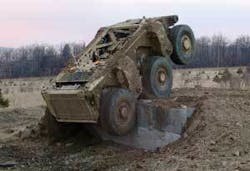By Courtney E. Howard
Unmanned ground vehicles (UGVs), an integral part of the U.S. Army’s Future Combat Systems, continue to advance in technology and functionality, as evidenced by recent releases from industry vendors. Various businesses continue to infuse UGVs with greater capabilities, payloads, maneuverability, autonomy, and flexibility, making them well suited to missions in a wide array of environments.
UGVs will most benefit today’s soldiers in urban environments such as hidden areas, unknown buildings, and reconnaissance maneuvers. Urban battles have resulted in large numbers of casualties in Iraq and Afghanistan.
The Experimental Unmanned Ground Vehicle, demonstrated during TechNet International 2006 in Washington, D.C., by DataPath of Duluth, Ga., is designed to alleviate much of the risk of human casualties in urban combat situations.
“This is an experimental program for urban warfare from DataPath that employs a sophisticated wireless communications link that allows the UGV to operate at greater distances in urban combat so soldiers can “see around the corner” while reducing their risk,” explains Michael L. Bouchard, chief scientist, Wireless Services division of DataPath Inc.
Crusher, developed by Carnegie Mellon’s National Robotics Engineering Center, is capable of autonomous operation at high speeds and in challenging terrain.
Designed primarily for urban warfare, the medium-size UGV can go through doors and climb stairs, carry an 800-pound payload, and move as fast as 40 miles per hour. The experimental vehicle not only provides real-time, high-quality video feedback, but also serves various functions, such as bomb detonation and disposal, soldier extrication from combat zones, communications, and IED (improvised explosive devices) jamming via an on-board device. What sets the DataPath vehicle apart from other solutions, however, is its line-of-sight (LOS) and non-line-of-sight (NLOS) communications link, according to company executives. Traditionally, UGVs have been known to suffer from limited communications bandwidth, a challenge that DataPath sought to overcome.
“The solution utilizes the latest developments in communications technology, with a strong emphasis on the integration of all the systems deployed on the UGV,” notes Bouchard. “The communication link (Data Link) has been tested to deliver NLOS as far as 2,000 meters and LOS up to 6,000 meters, have a low probability of interception, and deliver 18 megabits per second (Mbit/s) of information with an average latency of less than 50 milliseconds (ms) for video and less than 10 ms for vehicle failsafe and driving controls.”
The DataPath Experimental UGV is currently available for demonstration or evaluation. Several more UGV innovations targeted at urban environments are likely to arise in the coming months, thanks in large part to the 2006 DARPA Grand Challenge. (For more information, visit www.darpa.mil/grandchallenge.)
Whereas DataPath expanded urban UGV capabilities with an eye toward communications technology, Carnegie Mellon’s National Robotics Engineering Center (NREC) in Pittsburgh, Penn., concentrated on autonomy in the development of its Crusher UGV.
Crusher, part of the unmanned ground combat vehicle (UGCV) PerceptOR Integrated (UPI) program, is a 6.5-ton hybrid-electric robot designed to offer greater ruggedness, mobility, and payload-carrying capacity than manned vehicles of roughly the same size. Moreover, its advanced autonomy capabilities are intended to enable the large UGV to operate autonomously in complex, off-road terrains.
Crusher uses a combination of laser-radar and camera systems to react to and maneuver around obstacles, eliminating the need for user intervention while under way. NREC is looking to further expand the vehicle’s capabilities and maneuverability by using global planning utilities such as terrain data analysis to aid it in analyzing, planning, and executing mobility missions over extreme terrains.
Crusher is designed not for production, but to demonstrate the possibilities and contribute to the future of UGV technology in military applications. As part of the UPI program, DARPA and the U.S. Army will perform quarterly field tests of the vehicle over the next two years, placing an emphasis on expanding its ability to operate autonomously.
The latest advancements in UGV technology are not restricted to hardware alone. Companies, such as RE2 Inc. of Pittsburgh, Pa., with Real-Time Innovations (RTI) of Santa Clara, Calif., are devoted to furthering the software solutions associated with unmanned vehicles.
RE2 and RTI have entered into a nonexclusive strategic alliance to deliver a middleware solution for unmanned vehicles and robotic platforms that complies with the Joint Architecture for Unmanned Systems (JAUS). Mandated by the Department of Defense, JAUS is a software messaging protocol developed to establish a communications standard for unmanned systems.
RE2, a spinoff from Carnegie Mellon that specializes in agile defense robotics, and middleware supplier RTI are combining the RE2 JAUS software development kit (SDK) and RTI Data Distribution Service in a JAUS-compliant middleware system. The solution is designed to ensure reliable communications in real time, enable a scalable architecture by isolating the software from the hardware, and support JAUS.
The new solution meets the DOD JAUS mandate by providing customers the RTI Data Distribution Service enveloped in a JAUS wrapper, which includes the required component binaries and a software code library for sending and receiving JAUS messages, according to RTI management.

